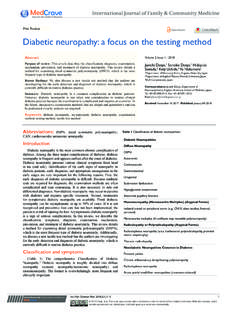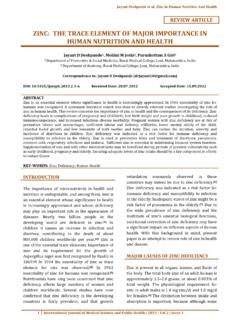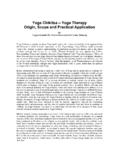Transcription of ADJUST: An automatic EEG artifact detector based …
1 ADJUST: an automatic eeg artifact detector based onthe joint use of spatial and temporal featuresANDREA MOGNON,a,bJORGE JOVICICH,aLORENZO BRUZZONE,candMARCO BUIATTIa,d,e,faFunctional NeuroImaging Laboratory, Center for Mind/Brain Sciences, Department of Cognitive and Education Sciences,University of Trento, Trento, ItalybNILab, Neuroinformatics Laboratory, Fondazione Bruno Kessler, Trento, ItalycDepartment of Information Engineering and Computer Science, University of Trento, Trento, ItalydINSERM, U992, Cognitive Neuroimaging Unit.
2 Gif/Yvette, FranceeCEA, DSV/I2BM, NeuroSpin Center, Gif/Yvette, FrancefUniversite Paris-Sud, Cognitive Neuroimaging Unit, Gif/Yvette, FranceAbstractA successful method for removing artifacts from electroencephalogram (EEG) recordings is Independent ComponentAnalysis (ICA), but its implementation remains largely user-dependent. Here, we propose a completely automaticalgorithm (ADJUST) that identifies artifacted independent components by combining stereotyped artifact -specificspatial and temporal features. Features were optimized to capture blinks, eye movements, and generic discontinuitieson a feature selection dataset.
3 Validation on a totally different EEG dataset shows that (1) ADJUST s classification ofindependent components largely matches a manual one by experts (agreement on of the data variance), and (2)Removal of the artifacted components detected by ADJUST leads to neat reconstruction of visual and auditory event-related potentials from heavily artifacted data. These results demonstrate that ADJUST provides a fast, efficient, andautomatic way to use ICA for artifact :Electroencephalography, Independent component analysis, EEG artifacts , EEG artefacts, Event-relatedpotentials, Ongoing brain activity, automatic classification, ThresholdingDue to its excellent temporal resolution, electroencephalography(EEG) is a widely used experimental technique to investigatehuman brain function by tracking the spatio-temporal neuraldynamics correlated to experimentally manipulated events(Niedermeyer & da Silva, 2005).
4 However, a major problemcommon to all EEG studies is that the activity due to artifacts hastypically much higher amplitude than the one generated by neu-ral sources. artifacts may have a physiological origin as eyemovements or muscle contractions, or non-biological causes aselectrode high-impedance or electric devices interference (Croft& Barry, 2000).In a typical event-related potential (ERP) paradigm, data aredivided in epochs time-locked to the stimulus, and artifacts areremoved by discarding epochs in which the EEG activity exceedssome predefined thresholds either in specific electrodes ( ,electrooculogram (EOG) signals for ocular movements) or in allelectrodes throughout the scalp.
5 artifact -free ERPs are thenobtained by averaging the data over the remaining epochs,thereby increasing the signal-to-noise ratio. However, this pro-cedure is problematic when only a few epochs are available, orwhen artifacts are very frequent, as in studies involving patientsor children. Moreover, it is inapplicable to studies focusing onslow non-event-locked activity arising from the continuous EEG( , slow brain oscillations (Vanhatalo, Palva, Holmes, Miller,Voipio, & Kaila, 2004) or long-range temporal correlations(Linkenkaer-Hansen, Nikouline, Palva, & Ilmoniemi, 2001)).
6 Alternative procedures consist of modelling the signals gen-erated by blinks or ocular movements and removing them fromthe data while preserving the remaining activity. Most of thesemethods are based on regressing out reference signals, usuallyrecorded near the eyes, from the EEG signals with a model ofartifact propagation, either in the time domain (Gratton, Coles,& Donchin, 1983; Kenemans, Molenaar, Verbaten, & Slangen,1991; Verleger, Gasser, & Mocks, 1982) or in the frequency do-main (Gasser, Sroka, & Mocks, 1985; Woestenburg, Verbaten, &Slangen, 1983).
7 However, because EEG and ocular activity mixbidirectionally (Oster & Stern, 1980; Peters, 1967), regressing outeye artifacts inevitably involves subtracting relevant neuralsignals from each recording as well as ocular activity (Croft &Barry, 2002; Jung, Makeig, Westerfield, Townsend, Courchesne,We thank Mariano Sigman and Stanislas Dehaene for sharing theEEG data, Francesca Bovolo and Michele Dalponte for helpful advice onthe use of the thresholding algorithm, and Sara Assecondi for valuablecomments on an earlier version of the correspondence to: Marco Buiatti, CEA/DSV/I2BM/NeuroSpin, INSERM U992 FCognitive Neuroimaging Unit, Ba t145 FPoint Courrier 156, Gif sur Yvette F-91191, France.)
8 48(2011), 229 240. Wiley Periodicals, Inc. Printed in the Society for Psychophysiological ResearchDOI: Sejnowski, 2000). Moreover, these methods do not workwithout reference signals, which are not always present for ocularmovements, and very difficult to obtain for other types of ar-tifacts (muscular, non-biological).A recent successful approach to this problem is the use ofindependent component analysis (ICA) (Jung, Humphries, Lee,Makeig, McKeown, Iragui, & Sejnowski, 1998), a statistical toolthat decomposes EEG data in a set of sources with maximallyindependent time courses.
9 ICA proved very efficient in separat-ing activity related to a large number of artifacts from neuralactivity by automatically segregating the former in specificindependent components (ICs) (Jung, Makeig, Humphries, Lee,McKeown, Iragui, & Sejnowski, 2000; Viga rio, Sa rela , Jousma -ki, Ha ma la inen, & Oja, 2000). Since the number of sources ispotentially much higher than the number of ICs (Baillet, Mosher,& Leahy, 2001; Liu, Dale, & Belliveau, 2002), this separation willnever be perfect (Groppe, Makeig, & Kutas, 2009).
10 However,after removing non-stereotyped artifacts by an accurate pre-processing of the data, it is possible to obtain clean ICAdecompositions (Onton, Westerfield, Townsend, & Makeig,2006), such that removing artifacted ICs from the data by sim-ple subtraction generally leads to marginal distortion of theremaining EEG data (Joyce, Gorodnitsky, & Kutas, 2004; Jung,Makeig, Humphries, et al., 2000).Nevertheless, the practical usability of ICA as a tool forartifact rejection has an important limitation: the detection of theICs associated with artifacts is time-consuming and involvessubjective decision making.









